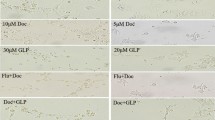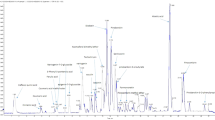Abstract
Tumor necrosis factor (TNF)-related apoptosis-inducing ligand (TRAIL/Apo2L) is a promising candidate for cancer therapy, however, emergence of drug resistance limits its potential use. Here, we report for the first time that epigallocatechin-3-gallate (EGCG), the major polyphenolic constituent of green tea, sensitizes TRAIL-resistant LNCaP cells to TRAIL-mediated apoptosis through modulation of intrinsic and extrinsic apoptotic pathways. When combined with EGCG, Apo2L/TRAIL exhibited enhanced apoptotic activity in LNCaP cells characterized by three major molecular events. First, apoptosis induction was accompanied by the upregulation of poly(ADP-ribose) polymerase cleavage and modulation of pro- and antiapoptotic Bcl2 family of proteins. A synergistic inhibition of inhibitors of apoptosis with concomitant increase in caspase cleavage was observed. Second, pretreatment of cells with EGCG resulted in modulation of death-inducing signaling cascade complex involving DR4/TRAIL R1, Fas-associated death domain and FLICE-inhibitory protein proteins. Last, we observed a synergistic inhibition in the invasion and migration of LNCaP cells. This effect was observed to be mediated through inhibition in the protein expression of vascular endothelial growth factor, uPA and angiopoietin 1 and 2. Further, the activity and protein expression of MMP-2, -3 and -9 and upregulation of TIMP1 in cells treated with a combination of EGCG and TRAIL was observed. These data might have implications for developing new strategies aimed at eliminating prostate cancer cells resistant to TRAIL.
This is a preview of subscription content, access via your institution
Access options
Subscribe to this journal
Receive 50 print issues and online access
$259.00 per year
only $5.18 per issue
Buy this article
- Purchase on Springer Link
- Instant access to full article PDF
Prices may be subject to local taxes which are calculated during checkout







Similar content being viewed by others
References
Adhami VM, Malik A, Zaman N, Sarfaraz S, Siddiqui IA, Syed DN et al. (2007). Combined inhibitory effects of green tea polyphenols and selective cyclooxygenase-2 inhibitors on the growth of human prostate cancer cells both in vitro and in vivo. Clin Cancer Res 13: 1611–1619.
Adhami VM, Siddiqui IA, Ahmad N, Gupta S, Mukhtar H . (2004). Oral consumption of green tea polyphenols inhibits insulin-like growth factor-I-induced signaling in an autochthonous mouse model of prostate cancer. Cancer Res 64: 8715–8722.
Bettuzzi S, Brausi M, Rizzi F, Castagnetti G, Peracchia G, Corti A . (2006). Chemoprevention of human prostate cancer by oral administration of green tea catechins in volunteers with high-grade prostate intraepithelial neoplasia: a preliminary report from a one-year proof-of-principle. Cancer Res 66: 1234–1240.
Bigelow RL, Cardelli JA . (2006). The green tea catechins, (−)-Epigallocatechin-3-gallate (EGCG) and (−)-Epicatechin-3-gallate (ECG), inhibit HGF/Met signaling in immortalized and tumorigenic breast epithelial cells. Oncogene 25: 1922–1930.
Cantarella G, Risuglia N, Dell'eva R, Lempereur L, Albini A, Pennisi G et al. (2006). TRAIL inhibits angiogenesis stimulated by VEGF expression in human glioblastoma cells. Br J Cancer 94: 1428–1435.
Chen X, Thakkar H, Tyan F, Gim S, Robinson H, Lee C et al. (2001). Constitutively active Akt is an important regulator of TRAIL sensitivity in prostate cancer. Oncogene 20: 6073–6083.
de Bock CE, Wang Y . (2004). Clinical significance of urokinase-type plasminogen activator receptor (uPAR) expression in cancer. Med Res Rev 24: 13–39.
Deeb D, Jiang H, Gao X, Hafner MS, Wong H, Divine G et al. (2004). Curcumin sensitizes prostate cancer cells to tumor necrosis factor-related apoptosis-inducing ligand/Apo2L by inhibiting nuclear factor-κB through suppression of IκBα phosphorylation. Mol Cancer Ther 3: 803–812.
Falschlehner C, Emmerich CH, Gerlach B, Walczak H . (2007). TRAIL signalling: decisions between life and death. Int J Biochem Cell Biol 39: 1462–1475.
Gao S, Lee P, Wang H, Gerald W, Adler M, Zhang L et al. (2005). The androgen receptor directly targets the cellular Fas/FasL-associated death domain protein-like inhibitory protein gene to promote the androgen-independent growth of prostate cancer cells. Mol Endocrinol 19: 1792–1802.
He Q, Huang Y, Sheikh MS . (2004). Proteasome inhibitor MG132 upregulates death receptor 5 and cooperates with Apo2L/TRAIL to induce apoptosis in Bax-proficient and -deficient cells. Oncogene 23: 2554–2558.
He Q, Lee DI, Rong R, Yu M, Luo X, Klein M et al. (2002). Endoplasmic reticulum calcium pool depletion-induced apoptosis is coupled with activation of the death receptor 5 pathway. Oncogene 21: 2623–2633.
Hu H, Jiang C, Schuster T, Li GX, Daniel PT, Lu J . (2006). Inorganic selenium sensitizes prostate cancer cells to TRAIL-induced apoptosis through superoxide/p53/Bax-mediated activation of mitochondrial pathway. Mol Cancer Ther 5: 1873–1882.
Jemal A, Siegel R, Ward E, Murray T, Xu J, Thun MJ . (2007). Cancer statistics, 2007. CA Cancer J Clin 57: 43–66.
Jian L, Xie LP, Lee AH, Binns CW . (2004). Protective effect of green tea against prostate cancer: a case-control study in southeast China. Int J Cancer 108: 130–135.
Koshida K, Konaka H, Imao T, Egawa M, Mizokami A, Namiki M . (2004). Comparison of two in vivo models for prostate cancer: orthotopic and intratesticular inoculation of LNCaP or PC-3 cells. Int J Urol 11: 1114–1121.
Lakshmikanthan V, Kaddour-Djebbar I, Lewis RW, Kumar MV . (2006). SAHA-sensitized prostate cancer cells to TNFalpha-related apoptosis-inducing ligand (TRAIL): mechanisms leading to synergistic apoptosis. Int J Cancer 119: 221–228.
Lam WH, Kazi A, Kuhn DJ, Chow LM, Chan AS, Dou QP et al. (2004). A potential prodrug for a green tea polyphenol proteasome inhibitor: evaluation of the peracetate ester of (-)-epigallocatechin gallate [(-)-EGCG]. Bioorg Med Chem 12: 5587–5593.
Landis-Piwowar KR, Kuhn DJ, Wan SB, Chen D, Chan TH, Dou QP . (2005). Evaluation of proteasome-inhibitory and apoptosis inducing potencies of novel (-)-EGCG analogs and their prodrugs. Int J Mol Med 15: 735–742.
Liston P, Fong WG, Korneluk RG . (2003). The inhibitors of apoptosis: there is more to life than Bcl2. Oncogene 22: 8568–8580.
Munshi A, McDonnell TJ, Meyn RE . (2002). Chemotherapeutic agents enhance TRAIL-induced apoptosis in prostate cancer cells. Cancer Chemother Pharmacol 50: 46–52.
Nencioni A, Wille L, Dal Bello G, Boy D, Cirmena G, Wesselborg S et al. (2005). Cooperative cytotoxicity of proteasome inhibitors and tumor necrosis factor-related apoptosis-inducing ligand in chemoresistant Bcl-2-overexpressing cells. Clin Cancer Res 11: 4259–4265.
Ozawa F, Friess H, Kleeff J, Xu ZW, Zimmermann A, Sheikh MS et al. (2001). Effects and expression of TRAIL and its apoptosis-promoting receptors in human pancreatic cancer. Cancer Lett 163: 71–81.
Qin J, Xie LP, Zheng XY, Wang YB, Bai Y, Shen HF et al. (2007). A component of green tea, (-)-epigallocatechin-3-gallate, promotes apoptosis in T24 human bladder cancer cells via modulation of the PI3K/Akt pathway and Bcl-2 family proteins. Biochem Biophys Res Commun 354: 852–857.
Saleem M, Kweon MH, Johnson JJ, Adhami VM, Elcheva I, Khan N et al. (2006). S100A4 accelerates tumorigenesis and invasion of human prostate cancer through the transcriptional regulation of matrix metalloproteinase 9. Proc Natl Acad Sci USA 103: 14825–14830.
Schimmer AD . (2004). Inhibitor of apoptosis proteins: translating basic knowledge into clinical practice. Cancer Res 64: 7183–7190.
Siddiqui IA, Adhami VM, Afaq F, Ahmad N, Mukhtar H . (2004). Modulation of phosphatidylinositol-3-kinase/protein kinase B- and mitogen-activated protein kinase-pathways by tea polyphenols in human prostate cancer cells. J Cell Biochem 91: 232–242.
Siddiqui IA, Adhami VM, Saleem M, Mukhtar H . (2006). Beneficial effects of tea and its polyphenols against prostate cancer. Mol Nutr Food Res 50: 130–143.
Siddiqui IA, Saleem M, Adhami VM, Asim M, Mukhtar H . (2007). Tea beverage in chemoprevention and chemotherapy of prostate cancer. Acta Pharmocol Sin 28: 1392–1408.
Stresemann C, Brueckner B, Musch T, Stopper H, Lyko F . (2006). Functional diversity of DNA methyltransferase inhibitors in human cancer cell lines. Cancer Res 66: 2794–2800.
Thurston G . (2003). Role of Angiopoietins and Tie receptor tyrosine kinases in angiogenesis and lymphangiogenesis. Cell Tissue Res 314: 61–68.
Yamaguchi K, Uzzo RG, Pimkina J, Makhov P, Golovine K, Crispen P et al. (2005). Methylseleninic acid sensitizes prostate cancer cells to TRAIL-mediated apoptosis. Oncogene 24: 5868–5877.
Zhang XD, Nguyen T, Thomas WD, Sanders JE, Hersey P . (2000). Mechanisms of resistance of normal cells to TRAIL induced apoptosis vary between different cell types. FEBS Lett 482: 193–199.
Acknowledgements
This original work for author's laboratory was supported by US PHS Grants RO1 CA 78809, RO1 CA 101039, RO1 CA 120451 and O'Brian center Grant P50 DK065303-01.
Author information
Authors and Affiliations
Corresponding author
Rights and permissions
About this article
Cite this article
Siddiqui, I., Malik, A., Adhami, V. et al. Green tea polyphenol EGCG sensitizes human prostate carcinoma LNCaP cells to TRAIL-mediated apoptosis and synergistically inhibits biomarkers associated with angiogenesis and metastasis. Oncogene 27, 2055–2063 (2008). https://doi.org/10.1038/sj.onc.1210840
Received:
Revised:
Accepted:
Published:
Issue Date:
DOI: https://doi.org/10.1038/sj.onc.1210840
Keywords
This article is cited by
-
Effects of artificial honey and epigallocatechin-3-gallate on streptococcus pyogenes
BMC Microbiology (2022)
-
Effect of epigallocatechin gallate on aluminum chloride-induced changes in behavior, biochemical parameters, and spermatogenesis of Sprague-Dawley rats
Beni-Suef University Journal of Basic and Applied Sciences (2020)
-
Epigallocatechin-3-gallate enhances ER stress-induced cancer cell apoptosis by directly targeting PARP16 activity
Cell Death Discovery (2017)
-
The alkyllysophospholipid edelfosine enhances TRAIL-mediated apoptosis in gastric cancer cells through death receptor 5 and the mitochondrial pathway
Tumor Biology (2016)
-
Recent progress on nutraceutical research in prostate cancer
Cancer and Metastasis Reviews (2014)



